The effect of student tardiness on learning
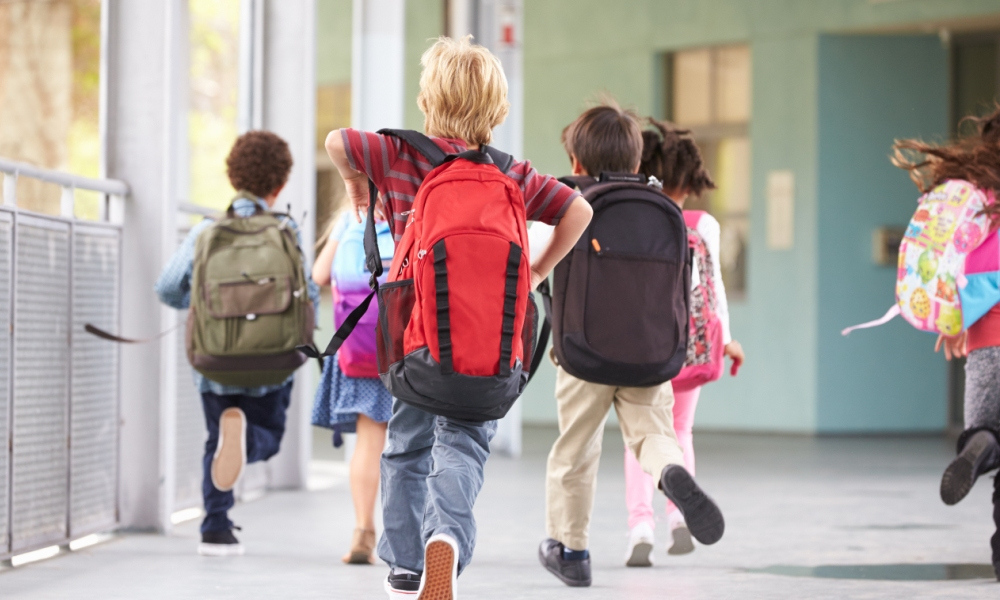
Several studies have shown that school tardiness has a negative impact on learning outcomes.
By the mere nature of arriving late and missing school hours, students receive fewer hours of instruction than students who are in class when the bell sounds.
But not only does a student who is consistently arriving late to school establish bad punctuality habits, their tardiness also disrupts the learning of other students in their classes.
A study by Hammill Institute on Disabilities (Caldarella, Christensen, Young & Densley, 2011), looked at decreasing tardiness in primary school-aged students using teacher-written praise notes.
The researchers found that students who are frequently late to school often miss out on important opening announcements and academic activities.
‘Teachers can become frustrated as late students disrupt instruction, often requiring reteaching of what they have missed. Tardy behavior can also negatively affect the overall classroom environment,' the study says.
Arriving late to school can also mean that students miss out on activities designed to build connections with their peers, potentially impacting their social interactions and creating a greater sense of alienation from their classmates.
Punishment or positive reinforcement?
So, how can teachers tackle the issue? The report suggests it is generally not helpful for teachers to punish late students once they get to class, because it could potentially aggravate the situation.
‘There appears to be a lack of empirical evidence that punishment for tardiness yields any positive results,' the study says.
Instead, the authors suggest using praise as a specific positive reinforcement strategy, as it has proved to be effective for addressing problem behaviour.
‘Praise has been recognized as perhaps the easiest modification teachers can make to address students' problem behaviors,' the study notes.
When implementing this strategy, the authors point out that there are several things to consider. Firstly, they suggest using recent school data to identify which students show a consistent pattern of being late. ‘For example, it makes little sense to intervene with a student who had a pattern of tardiness at the beginning of the school year but is currently tardy only occasionally.'
They also note that young students often rely on an adult to get them to school on time, and teachers should be cautious of the fact that the students' tardiness may be a result of parent behaviour rather than student behaviour. ‘In such cases, intervention may need to be directed more to the parents,' the study says.
A schoolwide plan
At a secondary school level, chronic tardiness can significantly reduce the minutes of instruction for all students enrolled in the class, not just the tardy student.
A US study titled Schoolwide intervention to reduce chronic tardiness at the middle and high school levels found that ‘instructional time lost to widespread tardiness is likely to significantly affect the capacity of the entire student population to meet rigorous academic standards'.
The research suggests that a system-level intervention is required to combat student tardiness, to ensure guidelines are current and consequences for tardy behaviour is implemented and effective.
The report recommends a preventative schoolwide plan include the following:
- active supervision of students in common areas during all transition periods
- clear definition and explicit teaching of expectations for behaviour during transition periods
- immediate and consistent consequences for tardiness
- data-based decision making with respect to intervention planning and monitoring of outcomes (Tyre, Feuerborn & Pierce 2011).
The impact on other students
In his 2014 academic paper – The achievement effects of tardy classmates: Evidence in urban elementary schools – Michael Gottfried explores the impact of tardy students' behaviour on their peers.
Gottfried acknowledges that if teachers respond to the educational needs of late students by reallocating regular class time, then other students are adversely affected and classroom instruction is slowed by this disruption.
‘With tardy students entering the school day at abnormal times and potentially missing a large number of cumulative instructional hours, teachers must divert their attention away from regular teaching time and towards remediation,' he says. ‘As such, there are negative effects on achievement generated when one student's actions impede learning for other classmates.'
References:
Caldarella, P., Christensen, L., Young, K. R., & Densley, C. (2011). Decreasing tardiness in elementary school students using teacher-written praise notes. Intervention in School and Clinic , 1053451211414186.
Gottfried, M. A. (2014). The achievement effects of tardy classmates: Evidence in urban elementary schools. School Effectiveness and School Improvement , 25(1), 3-28.
Tyre, A., Feuerborn, L., & Pierce, J. (2011). Schoolwide intervention to reduce chronic tardiness at the middle and high school levels. Preventing School Failure , 55(3), 132-139.
As a school leader, do you have a schoolwide plan in place to tackle the issue? How have you communicated this to staff, students and parents?
As a teacher, consider your own behaviour when a student arrives late to class: If you’re working with young students, is this a parent behaviour problem or a student behaviour problem? How do you ensure that on-time students are not adversely affected by this disruption?

Related articles

Effects of Tardiness to the Academic Performance of Grade 12 ABM Students inBestlink College of the Philippines School Year 2018-2019
- Willo Adrian Camadung Abalaing
- Emelyn Balsomo Cardinoza
- Mee Ann Naquila Lumandas
- Jennilyn Laurente Rioflorido
- Esther Alambra Ruiz
- Crystel-Joy S. Tamon
Many problems can affect the academic performance of the students. One of these is tardiness. It can widely affect the academic performance of the students because of missed classes or instructional hours of learning. It may cause failed accomplishments in homework, written exams, and projects. It may become a habit of some students that may lead them to more serious problems like the poor learning process. A qualitative method was used in the study. Using a descriptive research design, this study assessed the effects of tardiness on the academic performance of Grade 12 ABM students. There were four identified factors causing tardiness: anxiety, addiction to online games and social media, family problems, and household chores. Three academic variables were identified to be affected by students’ tardiness such as student’s projects, homework, and written exams. Data were collected by distributing questionnaires to 50 selected Grade 12 through purposive sampling. The results of the study revealed that tardiness affects the academic performance of the Grade 12 ABM Students in terms of these variables: (1) Project-Tardiness affects the student’s capacity to do their projects and pass it on time or before the deadline. (2) Homework-because of tardiness, students fail to pass their homework on time, while others depend on their classmates by copying their work. (3) Written Exams-due to tardiness in the class, the student’s capacity to take notes on the lectures resulted in the lack of notes to review for examinations, causing them to depend on their classmates. The results revealed that social media and online games are the most common factors causing tardiness. The results demonstrate the need for the teachers and school administrators to guide the Bestlink students in showing how to avoid tardiness so it will not affect their academic performance and their achievement of goals. To become academically excellent, it is very important that students should get enough sleep and avoid unnecessary activities. Prevention can positively affect their academic performance. Strong implementation of school policies must be applied to address the tardiness of the students and its effect on their academic performance.

How to Cite
- Endnote/Zotero/Mendeley (RIS)
Most read articles by the same author(s)
- Ericka Razon Contante, Ella Marie Geroy Toscano, Erica Reyes Domingo, Edelyn Balasta Almeniana, Ma. Jessica Buenaflor Rose, Crystel-Joy S. Tamon, Effects of Budgeting Students’ Allowance to the Academic Performance of Grade 12 ABM Students In Bestlink College Of The Philippines School Year 2018-2019 , Ascendens Asia Singapore – Bestlink College of the Philippines Journal of Multidisciplinary Research: Vol. 1 No. 1 (2019): Ascendens Asia Singapore – Bestlink College of the Philippines Journal of Multidisciplinary Research Abstracts, Vol.1, No.1, March 2019
- Rene Nicculo S. Deloso, Maria Theress A. Gales, Gloria Marie C. Labasan, Juvie B. Boneo, Rosario Janyll H. Laceda, Crystel-Joy S. Tamon, Budgeting Strategies and Its Impact to the Financial Decision-Making of Grade 12 ABM Students in Bestlink College of the Philippines School Year 2018-2019 , Ascendens Asia Singapore – Bestlink College of the Philippines Journal of Multidisciplinary Research: Vol. 1 No. 1 (2019): Ascendens Asia Singapore – Bestlink College of the Philippines Journal of Multidisciplinary Research Abstracts, Vol.1, No.1, March 2019
- Jomel D.R. Carmen, Thea Mae Escaṅo, Aira Hernandez, Shane Maurice Claire P. Mongaya, Jacque Ramos, Crystel-Joy S. Tamon, The Impact of Gadgets to the Academic Performance of Grade 12 ABM Students in Bestlink College of the Philippines, School Year 2018-2019 , Ascendens Asia Singapore – Bestlink College of the Philippines Journal of Multidisciplinary Research: Vol. 1 No. 1 (2019): Ascendens Asia Singapore – Bestlink College of the Philippines Journal of Multidisciplinary Research Abstracts, Vol.1, No.1, March 2019
- Rosemarie Bihison Barreto, John Paul Joyno Nalayog, April Mercado Tresreyes, Ej Pulido Rombao, Thrixie Khayte Marcelo, Crystel-Joy S. Tamon, Improper Budgeting of Allowance and its Effects in the Academic Performance of Grade 12 ABM Students in Bestlink College of the Philippines School Year 2018-2019 , Ascendens Asia Singapore – Bestlink College of the Philippines Journal of Multidisciplinary Research: Vol. 1 No. 1 (2019): Ascendens Asia Singapore – Bestlink College of the Philippines Journal of Multidisciplinary Research Abstracts, Vol.1, No.1, March 2019
- Angelica Bajaras Balagosa, Analyn Canedo, Julia Paula Dimabuyu Cunanan, Eric Tristan Galzote Moscare, Marbie Mutuc, Crystel-Joy S. Tamon, Impact of Romantic Relationship to the Academic Performance of Grade 12 ABM Students in Bestlink College of the Philippines School Year 2018-2019 , Ascendens Asia Singapore – Bestlink College of the Philippines Journal of Multidisciplinary Research: Vol. 1 No. 1 (2019): Ascendens Asia Singapore – Bestlink College of the Philippines Journal of Multidisciplinary Research Abstracts, Vol.1, No.1, March 2019
- Roann M. Cordovilla, Noemi Rose Santander, Cherie May Tupas, Jessa Halla, Beverly Baldos, Crystel-Joy S. Tamon, Effects of Social Media in Academic Performance of Grade 12 ABM Students in Bestlink College of the Philippines School Year 2018-2019 , Ascendens Asia Singapore – Bestlink College of the Philippines Journal of Multidisciplinary Research: Vol. 1 No. 1 (2019): Ascendens Asia Singapore – Bestlink College of the Philippines Journal of Multidisciplinary Research Abstracts, Vol.1, No.1, March 2019
- Juvelyn Garcia, John Kenneth Litang, Aris Obena, Hazel Villa, Manuel Gutierez, Crystel-Joy S. Tamon, Level of Satisfaction of Grade 12 ABM Students in Food Services in the School Canteen of Bestlink College of the Philippines School Year 2018-2019 , Ascendens Asia Singapore – Bestlink College of the Philippines Journal of Multidisciplinary Research: Vol. 1 No. 1 (2019): Ascendens Asia Singapore – Bestlink College of the Philippines Journal of Multidisciplinary Research Abstracts, Vol.1, No.1, March 2019
- Joan Marie Del Mundo Gavarra, Aeries Bringgel Vitales, Carmela Joyce Bautista Cabie, Evory Ann Yorong Estremos, Dayana Rose Gatan Santos, Crystel-Joy S. Tamon, Effects of Low of Self-Esteem to the Academic Performance of Grade 12 ABM Students in Bestlink College of the Philippines School Year 2018-2019 , Ascendens Asia Singapore – Bestlink College of the Philippines Journal of Multidisciplinary Research: Vol. 1 No. 1 (2019): Ascendens Asia Singapore – Bestlink College of the Philippines Journal of Multidisciplinary Research Abstracts, Vol.1, No.1, March 2019
- Diana B. Segovia, Ma. Jane V. Laurente, Nerissa S. Mendoza, Jerson P. Satuito, Mary Louise C. Calimotan, Crystel-Joy S. Tamon, The Effects of Tardiness to the Academic Performance of Grade 12 ABM Students in Bestlink College of the Philippines School Year 2018-2019 , Ascendens Asia Singapore – Bestlink College of the Philippines Journal of Multidisciplinary Research: Vol. 1 No. 1 (2019): Ascendens Asia Singapore – Bestlink College of the Philippines Journal of Multidisciplinary Research Abstracts, Vol.1, No.1, March 2019
- Menchie R. Madungit, Lorie Mae B. Bagapuro, Erica E. Gutierrez, Jennielyn B. Montaos, Nicky N. Laoreno, Crystel-Joy S. Tamon, Factors of Stress and Its Impact to the Academic Performances Grade 12 ABM in Bestlink College of the Philippines School Year 2018-2019 , Ascendens Asia Singapore – Bestlink College of the Philippines Journal of Multidisciplinary Research: Vol. 1 No. 1 (2019): Ascendens Asia Singapore – Bestlink College of the Philippines Journal of Multidisciplinary Research Abstracts, Vol.1, No.1, March 2019
Similar Articles
- Mary Joy Avila, Edna Bertos, Conney Lachica, Dinah Mae Narciso, Rachel Zepeda, Amelia Ablen, Ph.D., Impact of Broken Family on Academic Performance of Grade 6 Students at San Bartolome Elementary School , Ascendens Asia Singapore – Bestlink College of the Philippines Journal of Multidisciplinary Research: Vol. 2 No. 1 (2020): Ascendens Asia Singapore – Bestlink College of the Philippines Journal of Multidisciplinary Research Abstracts, Vol.2, No1, March 2020
You may also start an advanced similarity search for this article.


Attendance Matters: The Impact of Tardiness on Student Success
Good school attendance often starts with smaller steps, such as arriving and leaving on time. At Athlos schools, some of the most important learning opportunities for students occur in the morning where they often participate in class huddles, morning announcements, and develop relationships with their peers.
Students Who Arrive and Leave School Early Miss Out on Key Learning Opportunities

Chronic tardiness is when students are consistently late to class and can have dramatic results on a student’s future education and career. Similarly, students who leave school early miss out on valuable instructional time.
Athlos students who arrive late and leave early from school miss out on key learning opportunities such as morning huddles , morning announcements, academic activities, tests and quizzes, and social interactions with peers.
Chronically tardy students are more likely to accept that absence altogether is tolerated, often leading to chronic absenteeism . This not only reflects poorly on the students and the school, but can affect their peers as well. Research has found that not only do students who are chronically tardy perform worse on their test scores, but so do their more prompt peers. The less time students spend in the classroom means the less they can contribute; often leading to class being disrupted, placing group and class projects on hold, and making less significant peer connections.
How to Encourage Punctuality
Studies have shown that using praise as a positive reinforcement is an effective strategy for student attendance. However, family participation is also key to good attendance for younger students. Some of the Athlos tips for good attendance include:
- Establishing and keeping a schedule; children thrive on routine
- Going to bed and waking up earlier
- Preparing for the morning the night before by laying out outfits, packing backpacks, and pre-packing lunches
- If work schedules conflict, investigate other means of transportation, such as carpooling with other families
If your family consistently struggles with school attendance, professionals suggest tracking the average time you’re late by and adding that time accordingly to your schedule. For example: if you are consistently 15 to 30 minutes late in the morning, set your alarm 15 to 30 minutes earlier. Doing this creates a cushion of extra time for unexpected delays.
On Time Students Are Successful Students
Student attendance is one of the most common predictors of academic achievement. Students who consistently miss school hours develop habits that will lead into their adult life, affecting their education, career, and social connections. In contrast, students who participate fully in school activities will have more opportunities to achieve academically, make healthy and informed lifestyle choices, and develop Performance Character traits.
Absence and tardiness in the classroom are some of the most challenging and powerful factors to student success, but through careful self-examination and a little grit, Athlos families will find what can be done to improve attendance in the classroom.
thank you! made a big help to us
May I use this infographic in our school newsletter with attribution? Thank you in advance for your consideration. Adel DiOrio Principal, St. Johns Middle School St. Johns, MI
Hello Adel, you may use our infographic on the condition that you attribute it to Athlos Academies and link back to our website or attendance blog post. Thank you for asking!
Can I use it for being our Review Related Literature for Research 3. Thankyou for understanding our situation God bless you
Hello Darwin, you may use our content on the condition that you credit Athlos Academies and link back to our website if possible. Thank you!
May I ask who is the author of this study? It’s for our research purposes. Thank you and God bless:)
Hi Chris, Bryan Bennion is the author of this article. All of the information you are looking for has been credited throughout the article.
Hello I’m Cecil, can I used it as our Related Review Literature for our Research project. Thank you in advance and God bless you
Hi Cecil. Thank you for asking! Yes, you can use it with proper credit.
Hi! Can i use this for my research about tardiness of students? Thank you for understanding!
Hello Hannah, thank you for asking! Yes, you can use with proper credit.
Like!! Really appreciate you sharing this blog post.Really thank you! Keep writing.
Trackbacks & Pingbacks
Leave a reply, leave a reply cancel reply.
Your email address will not be published. Required fields are marked *
Save my name, email, and website in this browser for the next time I comment.
This site uses Akismet to reduce spam. Learn how your comment data is processed .
Athlos Academies
Quick links.
- Partner Portal
- Work at Athlos HQ
- Work at an Athlos School
- Apparel Store
Connect with Us

- Share full article
Advertisement
Supported by
How to Reduce Student Absenteeism
Readers discuss the reasons for the spike since the pandemic and how to lure students back.

Why School Absences Have ‘Exploded’ Almost Everywhere
The pandemic changed families’ lives and the culture of education: “Our relationship with school became optional.”
To the Editor:
“ Pandemic Effect: Absence From Schools Is Soaring ” (front page, March 30) highlights the persistent challenge of chronic absenteeism in U.S. schools. If pandemic-related “cultural shifts” are among the factors keeping students away from school, bringing them back may require us to rethink the culture of education itself.
Despite the efforts of many visionary educators, too many schools still offer a deskbound, test- and compliance-driven experience that leaves students passive, uninspired and flat-out bored.
Over the last two years, a pilot program in Salem, Mass. , has succeeded in cutting chronic absenteeism among middle schoolers in half by listening to students and designing learning with their interests in mind, including regular field trips, hands-on projects and mentoring with college students. Today, the chronic absenteeism rate among the pilot cohort of seventh and eighth graders hovers at 8 percent, in no small part because students don’t want to miss what’s on offer at school.
Educators can reset school culture by being adaptive, believing in teacher leadership and recognizing that powerful learning can happen outside classroom walls. Unlike the use of Band-Aids and gimmickry that do not result in long-term change, valuing a philosophy of “education everywhere,” as Salem has embraced, will result in improved attendance and academic growth.
Stephen Hinds Laura Tavares Stephen Zrike Chelsea Banks Mr. Hinds is president and Ms. Tavares is executive director of the WPS Institute, an education nonprofit. Dr. Zrike is superintendent and Ms. Banks is dean of innovation for Salem Public Schools.
This article brings light to an issue plaguing school districts across the country. As a former classroom teacher, I remember talking with students who returned to school after being absent. They would ask for the work they missed. While I could share the assignment, I could not possibly share the rest of what they missed, including the social and academic interaction with their peers, the instruction provided, the opportunity to ask questions while working through material and being part of a community.
When done right, school is more than a collection of assignments. It is a vibrant social fabric that provides a culture of belonging, and opportunities to grow and explore with trusted adults guiding the way.
The solution to the absenteeism problem is not easy. As the chief education officer at Mikva Challenge, a group that works to engage young people in the civic process and have their voices part of critical decision making affecting their lives, I know that for any solution to be successful, it must involve youth in the process.
Our default as adults is to make decisions in the best interest of children, without asking them what they think and whether an idea will work. Young people are not apathetic; they are uninvited. They care deeply about the issues that affect them. And when they are engaged in decision making, policy is better.
Jill Bass Chicago
We had mixed feelings when reading “Pandemic Effect: Absence From Schools Is Soaring.” On the one hand, it’s important for the public to understand that chronic absenteeism in America is no small problem. On the other hand, the article unwittingly minimized the deep struggle so many families experience, particularly those from underresourced backgrounds.
You quote a researcher who stated, “The problem got worse for everybody in the same proportional way,” but we question whether this accurately reflects the reality in America today. Based on our own and others’ research, we believe that families who struggled before the pandemic were much more vulnerable to its effects.
We cannot ignore just how much deeper Covid affected communities of color, communities with risk factors, communities in poverty and communities in rural areas. This does not negate anyone’s struggles; yet the struggle has been disproportionate. This cannot be ignored.
Zahava L. Friedman Keri Giordano Hillside, N.J. Dr. Friedman is an assistant professor and Dr. Giordano is an associate professor at the College of Health Professions and Human Services, Kean University.
My 12-year-old son has been absent from school most of this year and is a part of the chronic absenteeism statistics cited in the article. His attendance was excellent until he caught Covid twice in one year from school. He was 9 years old and has been chronically ill ever since.
It is shocking to me that the article never suggests that some absenteeism might be due to chronic illness from Covid.
One recent study suggested that as many as 5.8 million kids in the United States have had their health affected by long Covid. These statistics are highly contested, but given how reluctant our doctors have been to diagnose or treat our child for something that they cannot measure with any blood test, it is not surprising that we do not really know the full extent of this disease.
My child, and many other children like him, cannot go to school because they are struggling with the persistent life-altering symptoms of chronic illness. These children want to go back to school. Don’t leave them out of the story.
Sarah Mathis Pleasanton, Calif.
The root causes of chronic absenteeism in American public schools are as varied as the solutions needed to combat it. One often overlooked and underfunded strategy with the potential to re-engage students in learning is arts education.
A 2021 study on the benefits of arts instruction in the Boston Public Schools showed that increased access to arts education reduced student absenteeism, with a greater impact on students who had been chronically absent.
BPS Arts Expansion is a public-private partnership that has dramatically expanded access to quality arts education throughout the school district and enabled longitudinal research on its impact.
No one strategy will be the panacea for chronic absenteeism. But as districts across the country grapple with this issue, expanding access to in-school arts instruction warrants attention.
Marinell Rousmaniere Boston The writer is the president and C.E.O. of EdVestors, a nonprofit school improvement organization.

Rowan Glenn Takes Flight with Undergraduate Research
- by Molly Medin
- April 19, 2024
For Rowan Glenn, applying for the American Institute of Aeronautics and Astronautics, or AIAA, Jefferson Goblet Student Paper Award, wasn't top of mind while researching aviation with Assistant Professor of Mechanical and Aerospace Engineering Christina Harvey , who leads the Biologically Informed Research and Design, or BIRD , lab at the University of California, Davis.

So, it was a bit of a surprise when Glenn, a fourth-year mechanical engineering major, found out they had won the prestigious award for aerospace design and structures, typically presented to a Ph.D. student.
"It was a hectic month leading up to our research paper. I got so focused on the presentation about our research that I forgot that I had submitted for the award at all," they said. "I got through the presentation, and then a day later, Christina told me I won an award. I was like, 'I forgot I was doing that.'"
Between preparing to graduate and conducting award-winning research, plus their other obligations as a lead in UC Davis' liquid rocketry club and a machine shop tech at the Diane Bryant Engineering Student Design Center , or ESDC, Glenn is one busy undergraduate, going all in on everything they can.
For their research, Glenn collaborated with Lucas Dahlke, a fellow mechanical engineering major, and Andy Engilis, the curator at the UC Davis Museum of Wildlife and Fish Biology, to collect data on the wingspan of birds to learn about aviation.
Glenn's team used an infrared and visual light scanner to create 3D models of 18 prepared bird wings, provided by Engilis, across several species. Glenn then adapted these models with a slicing algorithm for 3D printing, which slices a model into layers that the 3D printer prints, to measure the morphology of birdwings by extracting information about the shape of the wings' airfoils, or parts of the wing that create lift.
From there, Glenn compared the aerodynamic characteristics of the airfoils from gliding birds to the airfoils of flapping birds to determine if there were any differences between them. The research showed a statistically insignificant difference in the aerodynamic efficiency of the different airfoils, concluding that further research is needed.
Glenn will continue this research in collaboration with the University of North Carolina using their larger database of wing scans.
Glenn wasn't initially interested in bird flight research, but kept an open mind when they joined Harvey's lab. That willingness to try anything, coupled with their engineering skills and drive to excel, led to their research being recognized.
When speaking about undergraduate research and not letting fear limit their opportunities, Glenn said, "You're not going to feel qualified because you're an undergrad. But that doesn't mean you can't do it. It just means you just got to start."
Rocket Science, Literally
Glenn continues to apply that same openness and drive in all aspects of their student life. As the engine lead in the Aggie Propulsion and Rocketry Lab , or APRL, the first liquid rocketry team at UC Davis, Glenn is currently designing their first rocket engine with the club. They will travel to the Mojave Desert to perform a hot fire test on their engine, a huge milestone in the engine's development.
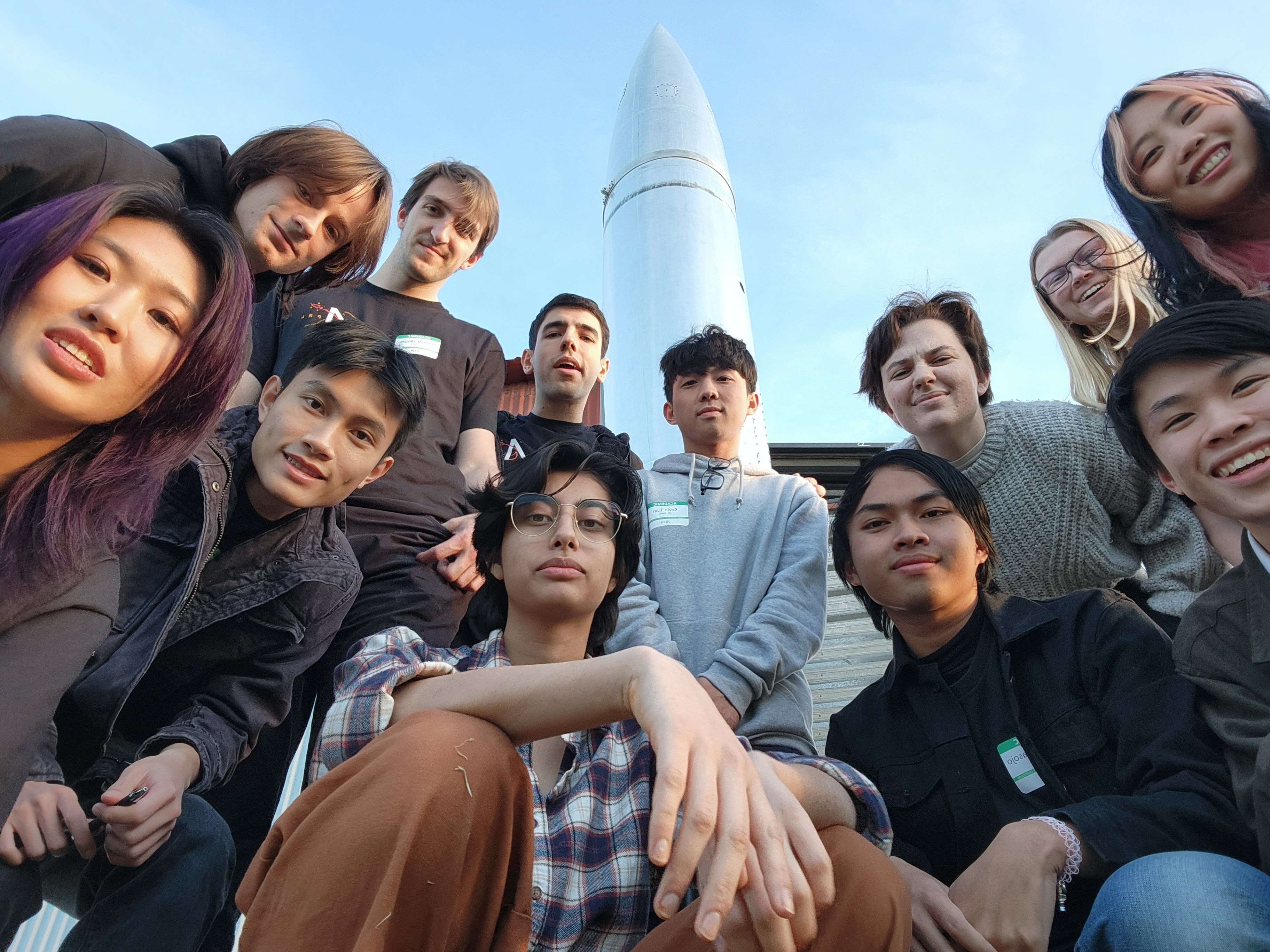
Another environment Glenn excels in is manufacturing at the ESDC. Glenn works part-time as a machine shop tech, getting more hands-on engineering experience and developing manufacturing knowledge. They maintain and service machines in the shop, train students to use shop equipment and manufacturing techniques and implement new organizational systems for the shop to improve the workflow and functionality of the shop.
Glenn is continually pushing to learn something new and apply maximum effort in all of their roles. They have learned that fear shouldn't stop them from trying out something new, which Glenn believes is a key part of the college experience and finding success.
"The thing I try to remind myself of is, it's not that I'm not finding it hard because I'm not competent enough," said Glenn. "I'm finding this difficult or confusing because the work is difficult and confusing. It's complicated engineering stuff. This work is hard. This is literally rocket science. That's why I'm finding it difficult, not because I'm not good enough to do this."
In their lead role at APRL, they make it a point to teach younger students about their lessons learned in intimidating research labs about fighting imposter syndrome and confidence.
Glenn plans to continue research as an undergraduate student, keep trying new things, and apply to grad school in a few years after graduating and starting work. In winning the Jefferson Goblet Student Paper Award, Glenn found a bit of outside validation that their plan, or lack thereof, is working.
"I like to joke with my friends that I'm an award-winning aerospace engineer now. I think it has solidified for me that just starting something and seeing what happens is a valid way to get work done."
Primary Category
Biostatistics Graduate Program
Yeji ko is first author of annals of epidemiology paper.
Posted by duthip1 on Thursday, April 18, 2024 in News .
Congratulations to PhD student Yeji Ko on the publication of Adjustment for duration of employment in occupational epidemiology in the June 2024 issue of Annals of Epidemiology (appearing online ahead of print this week). Professor Ben French , who was r ecently elected to the National Council for Radiation Protection and Measurements , is the paper’s corresponding author. Ko, French, and colleagues at Oak Ridge Associated Universities examined the healthy worker survivor effect in relation to radiation risk among nuclear workers, using simulation studies to arrive at reliable results and conclude that “it is crucial to flexibly adjust for duration of employment to account for confounding arising from the healthy worker survivor effect in occupational epidemiology.” The work was made possible by the Oak Ridge Associated Universities (ORAU) Directed Research and Development Grant, which promotes collaborations between universities and ORAU scientists for foundational research efforts.
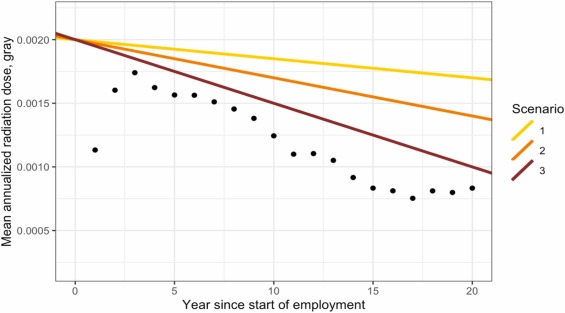
Tags: publications
Leave a Response
You must be logged in to post a comment
To revisit this article, visit My Profile, then View saved stories .
- Backchannel
- Newsletters
- WIRED Insider
- WIRED Consulting
Amanda Hoover

Students Are Likely Writing Millions of Papers With AI

Students have submitted more than 22 million papers that may have used generative AI in the past year, new data released by plagiarism detection company Turnitin shows.
A year ago, Turnitin rolled out an AI writing detection tool that was trained on its trove of papers written by students as well as other AI-generated texts. Since then, more than 200 million papers have been reviewed by the detector, predominantly written by high school and college students. Turnitin found that 11 percent may contain AI-written language in 20 percent of its content, with 3 percent of the total papers reviewed getting flagged for having 80 percent or more AI writing. (Turnitin is owned by Advance, which also owns Condé Nast, publisher of WIRED.) Turnitin says its detector has a false positive rate of less than 1 percent when analyzing full documents.
ChatGPT’s launch was met with knee-jerk fears that the English class essay would die . The chatbot can synthesize information and distill it near-instantly—but that doesn’t mean it always gets it right. Generative AI has been known to hallucinate , creating its own facts and citing academic references that don’t actually exist. Generative AI chatbots have also been caught spitting out biased text on gender and race . Despite those flaws, students have used chatbots for research, organizing ideas, and as a ghostwriter . Traces of chatbots have even been found in peer-reviewed, published academic writing .
Teachers understandably want to hold students accountable for using generative AI without permission or disclosure. But that requires a reliable way to prove AI was used in a given assignment. Instructors have tried at times to find their own solutions to detecting AI in writing, using messy, untested methods to enforce rules , and distressing students. Further complicating the issue, some teachers are even using generative AI in their grading processes.
Detecting the use of gen AI is tricky. It’s not as easy as flagging plagiarism, because generated text is still original text. Plus, there’s nuance to how students use gen AI; some may ask chatbots to write their papers for them in large chunks or in full, while others may use the tools as an aid or a brainstorm partner.
Students also aren't tempted by only ChatGPT and similar large language models. So-called word spinners are another type of AI software that rewrites text, and may make it less obvious to a teacher that work was plagiarized or generated by AI. Turnitin’s AI detector has also been updated to detect word spinners, says Annie Chechitelli, the company’s chief product officer. It can also flag work that was rewritten by services like spell checker Grammarly, which now has its own generative AI tool . As familiar software increasingly adds generative AI components, what students can and can’t use becomes more muddled.
Detection tools themselves have a risk of bias. English language learners may be more likely to set them off; a 2023 study found a 61.3 percent false positive rate when evaluating Test of English as a Foreign Language (TOEFL) exams with seven different AI detectors. The study did not examine Turnitin’s version. The company says it has trained its detector on writing from English language learners as well as native English speakers. A study published in October found that Turnitin was among the most accurate of 16 AI language detectors in a test that had the tool examine undergraduate papers and AI-generated papers.

Andy Greenberg

Matt Burgess

Caroline Haskins

Jessica Rawnsley
Schools that use Turnitin had access to the AI detection software for a free pilot period, which ended at the start of this year. Chechitelli says a majority of the service’s clients have opted to purchase the AI detection. But the risks of false positives and bias against English learners have led some universities to ditch the tools for now. Montclair State University in New Jersey announced in November that it would pause use of Turnitin’s AI detector. Vanderbilt University and Northwestern University did the same last summer.
“This is hard. I understand why people want a tool,” says Emily Isaacs, executive director of the Office of Faculty Excellence at Montclair State. But Isaacs says the university is concerned about potentially biased results from AI detectors, as well as the fact that the tools can’t provide confirmation the way they can with plagiarism. Plus, Montclair State doesn’t want to put a blanket ban on AI, which will have some place in academia. With time and more trust in the tools, the policies could change. “It’s not a forever decision, it’s a now decision,” Isaacs says.
Chechitelli says the Turnitin tool shouldn’t be the only consideration in passing or failing a student. Instead, it’s a chance for teachers to start conversations with students that touch on all of the nuance in using generative AI. “People don’t really know where that line should be,” she says.
You Might Also Like …
In your inbox: The best and weirdest stories from WIRED’s archive
Jeffrey Epstein’s island visitors exposed by data broker
8 Google employees invented modern AI. Here’s the inside story
The crypto fraud kingpin who almost got away
It's shadow time! How to view the solar eclipse, online and in person

Kate Knibbs

Will Knight

Lauren Goode

Reece Rogers

Steven Levy

Morgan Meaker

Tom Simonite

Joel Khalili

Apr. 19, 2024
Jaihee choi wins ibs distinguished student paper award, doctoral student recognized for statistical methodology that could aid cancer research..
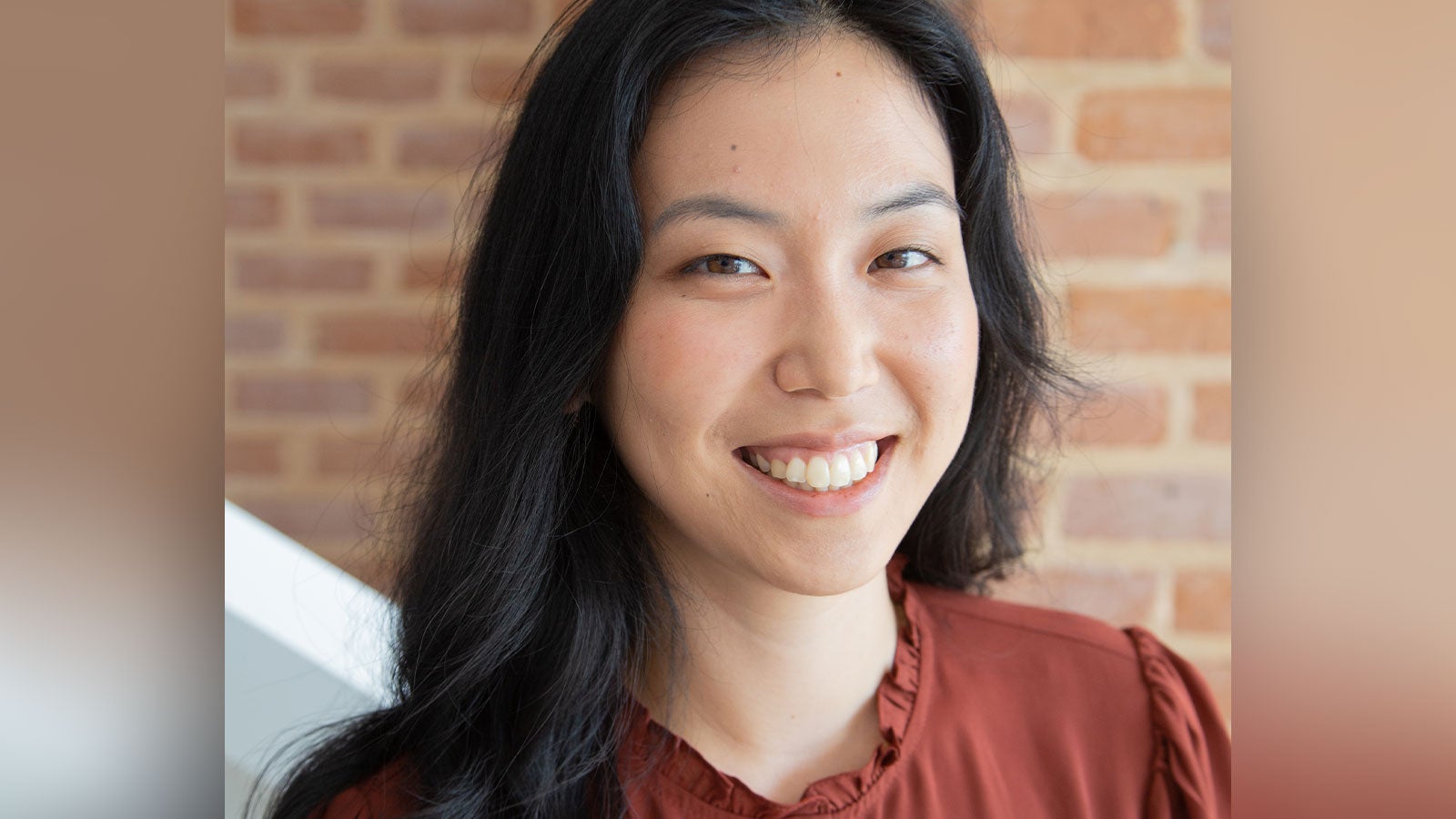
Jaihee Choi, a fifth-year doctoral student in statistics (STAT) at Rice, has won a Distinguished Student Paper Award from the Eastern North American Region (ENAR) of the International Biometric Society.
Her paper is titled “Variance Components Tests for Genetic Association with Multiple Interval-Censored Outcomes,” and was co-authored by Ryan Sun, adjunct assistant professor of STAT at Rice and assistant professor of biostatistics at MD Anderson Cancer Center.
“In this paper,” Choi said, “we develop a statistical methodology to associate a set of genetic variants, such as a gene, with multiple interval-censored, time-to-event outcomes so we can better understand the contribution of genetic mutations to complex physical outcomes, such as cancer.”
Choi earned her B.S. in applied and computational mathematics and statistics from the University of Notre Dame in 2019. She was formally presented with the award during the ENAR spring meeting held March 10-13 in Baltimore.
Numbers, Facts and Trends Shaping Your World
Read our research on:
Full Topic List
Regions & Countries
- Publications
- Our Methods
- Short Reads
- Tools & Resources
Read Our Research On:
About 1 in 4 U.S. teachers say their school went into a gun-related lockdown in the last school year
Twenty-five years after the mass shooting at Columbine High School in Colorado , a majority of public K-12 teachers (59%) say they are at least somewhat worried about the possibility of a shooting ever happening at their school. This includes 18% who say they’re extremely or very worried, according to a new Pew Research Center survey.
Pew Research Center conducted this analysis to better understand public K-12 teachers’ views on school shootings, how prepared they feel for a potential active shooter, and how they feel about policies that could help prevent future shootings.
To do this, we surveyed 2,531 U.S. public K-12 teachers from Oct. 17 to Nov. 14, 2023. The teachers are members of RAND’s American Teacher Panel, a nationally representative panel of public school K-12 teachers recruited through MDR Education. Survey data is weighted to state and national teacher characteristics to account for differences in sampling and response to ensure they are representative of the target population.
We also used data from our 2022 survey of U.S. parents. For that project, we surveyed 3,757 U.S. parents with at least one child younger than 18 from Sept. 20 to Oct. 2, 2022. Find more details about the survey of parents here .
Here are the questions used for this analysis , along with responses, and the survey methodology .
Another 31% of teachers say they are not too worried about a shooting occurring at their school. Only 7% of teachers say they are not at all worried.
This survey comes at a time when school shootings are at a record high (82 in 2023) and gun safety continues to be a topic in 2024 election campaigns .
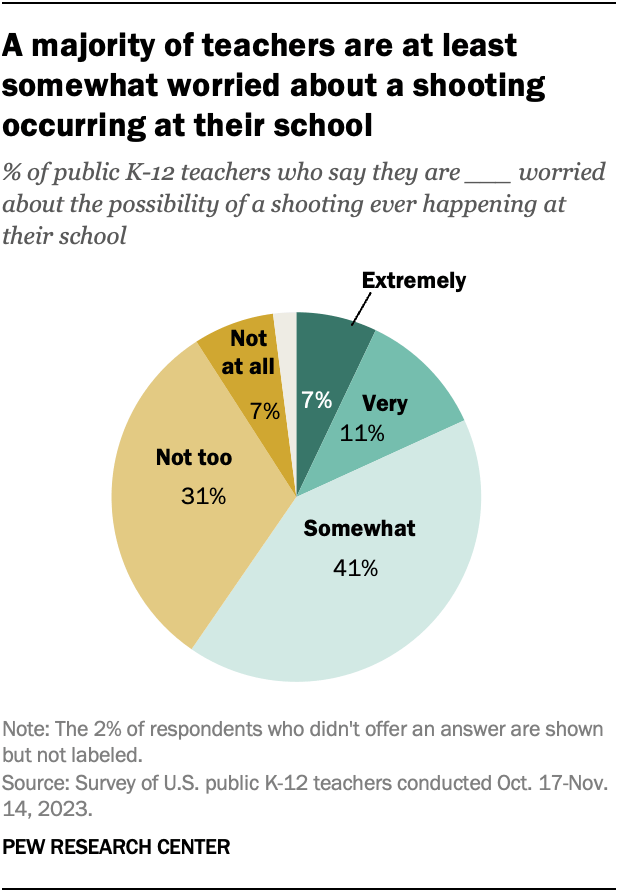
Teachers’ experiences with lockdowns
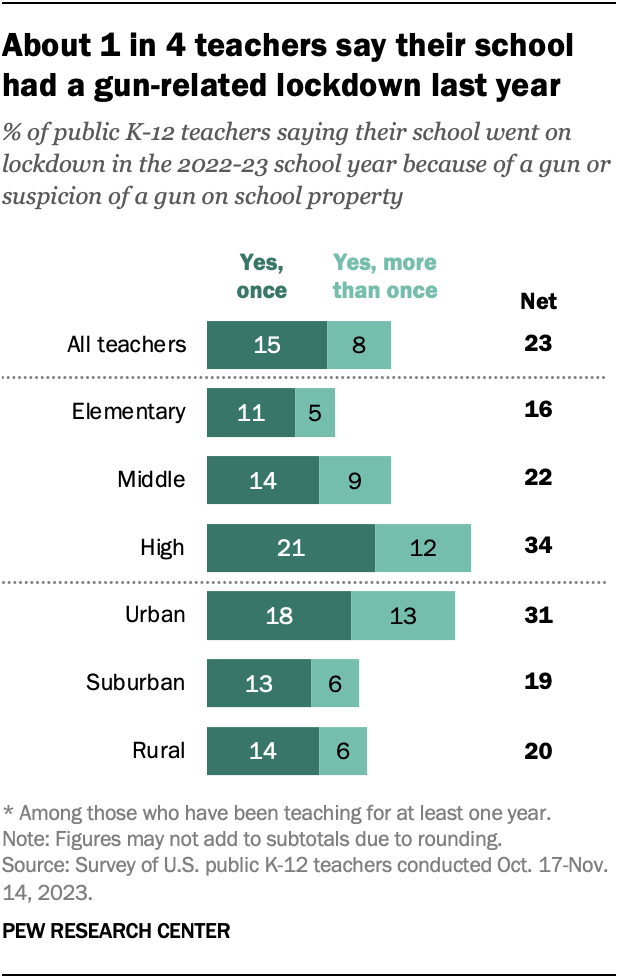
About a quarter of teachers (23%) say they experienced a lockdown in the 2022-23 school year because of a gun or suspicion of a gun at their school. Some 15% say this happened once during the year, and 8% say this happened more than once.
High school teachers are most likely to report experiencing these lockdowns: 34% say their school went on at least one gun-related lockdown in the last school year. This compares with 22% of middle school teachers and 16% of elementary school teachers.
Teachers in urban schools are also more likely to say that their school had a gun-related lockdown. About a third of these teachers (31%) say this, compared with 19% of teachers in suburban schools and 20% in rural schools.
Do teachers feel their school has prepared them for an active shooter?
About four-in-ten teachers (39%) say their school has done a fair or poor job providing them with the training and resources they need to deal with a potential active shooter.
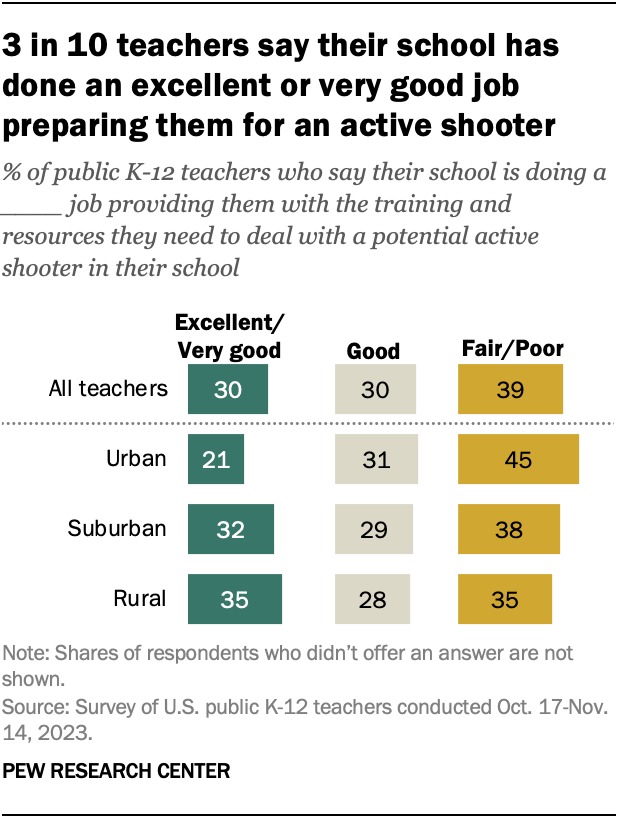
A smaller share (30%) give their school an excellent or very good rating, and another 30% say their school has done a good job preparing them.
Teachers in urban schools are the least likely to say their school has done an excellent or very good job preparing them for a potential active shooter. About one-in-five (21%) say this, compared with 32% of teachers in suburban schools and 35% in rural schools.
Teachers who have police officers or armed security stationed in their school are more likely than those who don’t to say their school has done an excellent or very good job preparing them for a potential active shooter (36% vs. 22%).
Overall, 56% of teachers say they have police officers or armed security stationed at their school. Majorities in rural schools (64%) and suburban schools (56%) say this, compared with 48% in urban schools.
Only 3% of teachers say teachers and administrators at their school are allowed to carry guns in school. This is slightly more common in school districts where a majority of voters cast ballots for Donald Trump in 2020 than in school districts where a majority of voters cast ballots for Joe Biden (5% vs. 1%).
What strategies do teachers think could help prevent school shootings?
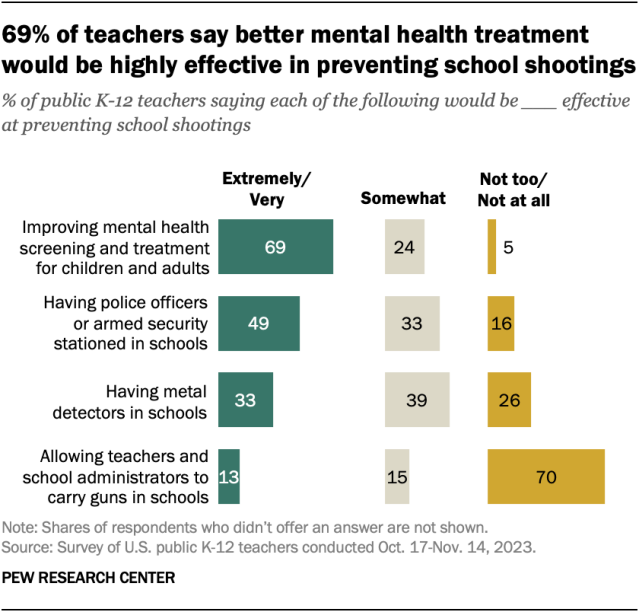
The survey also asked teachers how effective some measures would be at preventing school shootings.
Most teachers (69%) say improving mental health screening and treatment for children and adults would be extremely or very effective.
About half (49%) say having police officers or armed security in schools would be highly effective, while 33% say the same about metal detectors in schools.
Just 13% say allowing teachers and school administrators to carry guns in schools would be extremely or very effective at preventing school shootings. Seven-in-ten teachers say this would be not too or not at all effective.
How teachers’ views differ by party
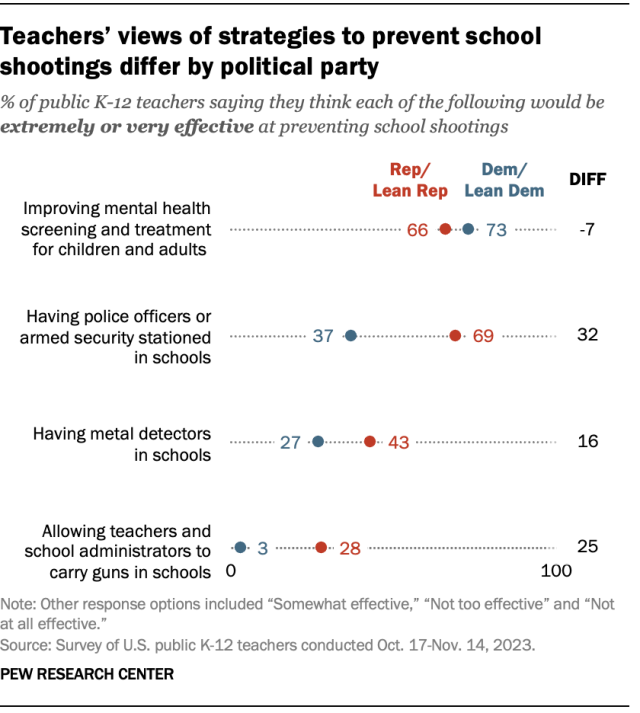
Republican and Republican-leaning teachers are more likely than Democratic and Democratic-leaning teachers to say each of the following would be highly effective:
- Having police officers or armed security in schools (69% vs. 37%)
- Having metal detectors in schools (43% vs. 27%)
- Allowing teachers and school administrators to carry guns in schools (28% vs. 3%)
And while majorities in both parties say improving mental health screening and treatment would be highly effective at preventing school shootings, Democratic teachers are more likely than Republican teachers to say this (73% vs. 66%).
Parents’ views on school shootings and prevention strategies
In fall 2022, we asked parents a similar set of questions about school shootings.
Roughly a third of parents with K-12 students (32%) said they were extremely or very worried about a shooting ever happening at their child’s school. An additional 37% said they were somewhat worried.
As is the case among teachers, improving mental health screening and treatment was the only strategy most parents (63%) said would be extremely or very effective at preventing school shootings. And allowing teachers and school administrators to carry guns in schools was seen as the least effective – in fact, half of parents said this would be not too or not at all effective. This question was asked of all parents with a child younger than 18, regardless of whether they have a child in K-12 schools.
Like teachers, parents’ views on strategies for preventing school shootings differed by party.
Note: Here are the questions used for this analysis , along with responses, and the survey methodology .
About half of Americans say public K-12 education is going in the wrong direction
What public k-12 teachers want americans to know about teaching, what’s it like to be a teacher in america today, race and lgbtq issues in k-12 schools, from businesses and banks to colleges and churches: americans’ views of u.s. institutions, most popular.
1615 L St. NW, Suite 800 Washington, DC 20036 USA (+1) 202-419-4300 | Main (+1) 202-857-8562 | Fax (+1) 202-419-4372 | Media Inquiries
Research Topics
- Age & Generations
- Coronavirus (COVID-19)
- Economy & Work
- Family & Relationships
- Gender & LGBTQ
- Immigration & Migration
- International Affairs
- Internet & Technology
- Methodological Research
- News Habits & Media
- Non-U.S. Governments
- Other Topics
- Politics & Policy
- Race & Ethnicity
- Email Newsletters
ABOUT PEW RESEARCH CENTER Pew Research Center is a nonpartisan fact tank that informs the public about the issues, attitudes and trends shaping the world. It conducts public opinion polling, demographic research, media content analysis and other empirical social science research. Pew Research Center does not take policy positions. It is a subsidiary of The Pew Charitable Trusts .
Copyright 2024 Pew Research Center
Terms & Conditions
Privacy Policy
Cookie Settings
Reprints, Permissions & Use Policy
Academia.edu no longer supports Internet Explorer.
To browse Academia.edu and the wider internet faster and more securely, please take a few seconds to upgrade your browser .
Enter the email address you signed up with and we'll email you a reset link.
- We're Hiring!
- Help Center

The Cause of Tardiness among Senior High School Students

Related Papers
Arian Ganzagan
Miraluna Tagactac
Jalyn Lacsinto
ntroduction This chapter represent the background of the study statement of the problem onceptual framework significance of the study scope and definition of term. This study is about effect of ardiness of 10-Rizal student unwillingnes. of doing a particular activity in an early time as a student tardiness ay affect activities and performances in especially academic subject that may cause failures of some student. Based on Student of Nangka High School come late to school and as a result academic subject will be ffected as well as the grades that its why every junior High School students like going to bed at night. eading, wattpad ,watching k-drama and many more by eliminating those bad habits it can help student to mprove their attendance in school. The researcher want to know how tardiness can effect student specifically to understand these of few tudent of Nangka High School and for us to give a tips and advice that can materialized and become effective o the students to eliminate this bad habbits and it is the tardiness. ignificance of the Study The Significance of the Study is to help the students know the causes of habitual tardiness and nderstand the underlying attitudes the makes tardiness being habitual.
Marjay Asajar
Pedagogical Research
Lectito Journals
Late coming to school has become a major problem in many schools, particularly township schools with serious consequences. Current research has demonstrated that many schools in South Africa are performing badly due to inefficient use of the teaching and learning time. In this article, we argue that while major administrative interventions are undertaken to improve the quality of learning and teaching, it seems that very little attention is paid to late-coming. Late-coming has become a cancer that saps away big interventions and strays the performance of selected township schools in a different direction. The purpose of this research is to investigate the causes of late-coming among high school students in selected secondary schools of Shoshanguve. A qualitative approach was used to draw data from high school students in selected secondary schools of Shoshanguve. The findings reveal that late-coming is common among learners in selected secondary schools of Shoshanguve. It happens every day for varying reasons. We recommended practical solutions ranging from administrative improvement to learner behavioural change.
Mitchie Geil Salvador
This study aimed to systematically review studies that investigate factors associated with students lateness behavior and dealing strategies. There were at least 24 papers and reports reviewed regarding lateness behavior. The related journal papers and reports on factor associated with students lateness behavior and dealing strategies were downloaded with cut off limit from 1991 to 2013. The papers and reports were then analyzed and organized according to the definitions of lateness and various factors associated with students lateness behavior and dealing strategies. However, the finding of this study indicate that there were conclusive evidence from the reviewed literature regarding students lateness behavior, yet the number of articles supporting it was small. Finally, conclusion of the study indicate tha dealing with disruptive behavior in the classroom is one of the most challenging aspects of being a professor and the study recommended further investigations and analysis could be beneficial to obtain a complete vision of patterns of lateness behavior and coping strategies for the student.
Johnsome Salva
joe melchor montejo
Generally, class tardiness is defined as students not attending lecture on time and not being present in the time set. After attending lectures for a period of time, students start getting to know the lectures are conducted and therefore assume that there will be no constructive activities happen for the first few minutes of the lecture. Class tardiness influences the students themselves as well as others. As generally known, students who possess regular attendance tend to achieve better results as success is related to one’s punctuality. Students who are late to class will also cause disruption to other students. Indeed, many previous researches indicated that class tardiness among the students is a common phenomenon. Some of the researches mentioned that students who are tardy tend to achieve lower grades compare to others and sleep late is the main reason. Therefore, this research will further investigate the phenomenon of class tardiness..
RELATED PAPERS
arnie rose bala
leserio ligtas
Shelina Bhamani
Dionisio Salorio
Mosopefoluwa A
Mark Joshoa Cadaoas
Oladapo K A Y O D E Abiodun
desiree tamayo
ralph obelidor
steeven espiritu
Sally Murray
Edlight Mutungwe
Madel Rafael
Bashiru Mohammed
Justice Agyei Ampofo
Developmental Psychology
Adam Winsler , Taryn Morrissey
Daniel B . Asamoah
Gesa Bright Academy
Education Research Papers
Richard Tabulawa
Nana Nguyen
Richard Tabulawa , nicholas kutor
Jasmin Gimena
Joseph Seyram Agbenyega
malata jonathan
- We're Hiring!
- Help Center
- Find new research papers in:
- Health Sciences
- Earth Sciences
- Cognitive Science
- Mathematics
- Computer Science
- Academia ©2024
- MyU : For Students, Faculty, and Staff
Fall 2024 CSCI Special Topics Courses
Cloud computing.
Meeting Time: 09:45 AM‑11:00 AM TTh Instructor: Ali Anwar Course Description: Cloud computing serves many large-scale applications ranging from search engines like Google to social networking websites like Facebook to online stores like Amazon. More recently, cloud computing has emerged as an essential technology to enable emerging fields such as Artificial Intelligence (AI), the Internet of Things (IoT), and Machine Learning. The exponential growth of data availability and demands for security and speed has made the cloud computing paradigm necessary for reliable, financially economical, and scalable computation. The dynamicity and flexibility of Cloud computing have opened up many new forms of deploying applications on infrastructure that cloud service providers offer, such as renting of computation resources and serverless computing. This course will cover the fundamentals of cloud services management and cloud software development, including but not limited to design patterns, application programming interfaces, and underlying middleware technologies. More specifically, we will cover the topics of cloud computing service models, data centers resource management, task scheduling, resource virtualization, SLAs, cloud security, software defined networks and storage, cloud storage, and programming models. We will also discuss data center design and management strategies, which enable the economic and technological benefits of cloud computing. Lastly, we will study cloud storage concepts like data distribution, durability, consistency, and redundancy. Registration Prerequisites: CS upper div, CompE upper div., EE upper div., EE grad, ITI upper div., Univ. honors student, or dept. permission; no cr for grads in CSci. Complete the following Google form to request a permission number from the instructor ( https://forms.gle/6BvbUwEkBK41tPJ17 ).
CSCI 5980/8980
Machine learning for healthcare: concepts and applications.
Meeting Time: 11:15 AM‑12:30 PM TTh Instructor: Yogatheesan Varatharajah Course Description: Machine Learning is transforming healthcare. This course will introduce students to a range of healthcare problems that can be tackled using machine learning, different health data modalities, relevant machine learning paradigms, and the unique challenges presented by healthcare applications. Applications we will cover include risk stratification, disease progression modeling, precision medicine, diagnosis, prognosis, subtype discovery, and improving clinical workflows. We will also cover research topics such as explainability, causality, trust, robustness, and fairness.
Registration Prerequisites: CSCI 5521 or equivalent. Complete the following Google form to request a permission number from the instructor ( https://forms.gle/z8X9pVZfCWMpQQ6o6 ).
Visualization with AI
Meeting Time: 04:00 PM‑05:15 PM TTh Instructor: Qianwen Wang Course Description: This course aims to investigate how visualization techniques and AI technologies work together to enhance understanding, insights, or outcomes.
This is a seminar style course consisting of lectures, paper presentation, and interactive discussion of the selected papers. Students will also work on a group project where they propose a research idea, survey related studies, and present initial results.
This course will cover the application of visualization to better understand AI models and data, and the use of AI to improve visualization processes. Readings for the course cover papers from the top venues of AI, Visualization, and HCI, topics including AI explainability, reliability, and Human-AI collaboration. This course is designed for PhD students, Masters students, and advanced undergraduates who want to dig into research.
Registration Prerequisites: Complete the following Google form to request a permission number from the instructor ( https://forms.gle/YTF5EZFUbQRJhHBYA ). Although the class is primarily intended for PhD students, motivated juniors/seniors and MS students who are interested in this topic are welcome to apply, ensuring they detail their qualifications for the course.
Visualizations for Intelligent AR Systems
Meeting Time: 04:00 PM‑05:15 PM MW Instructor: Zhu-Tian Chen Course Description: This course aims to explore the role of Data Visualization as a pivotal interface for enhancing human-data and human-AI interactions within Augmented Reality (AR) systems, thereby transforming a broad spectrum of activities in both professional and daily contexts. Structured as a seminar, the course consists of two main components: the theoretical and conceptual foundations delivered through lectures, paper readings, and discussions; and the hands-on experience gained through small assignments and group projects. This class is designed to be highly interactive, and AR devices will be provided to facilitate hands-on learning. Participants will have the opportunity to experience AR systems, develop cutting-edge AR interfaces, explore AI integration, and apply human-centric design principles. The course is designed to advance students' technical skills in AR and AI, as well as their understanding of how these technologies can be leveraged to enrich human experiences across various domains. Students will be encouraged to create innovative projects with the potential for submission to research conferences.
Registration Prerequisites: Complete the following Google form to request a permission number from the instructor ( https://forms.gle/Y81FGaJivoqMQYtq5 ). Students are expected to have a solid foundation in either data visualization, computer graphics, computer vision, or HCI. Having expertise in all would be perfect! However, a robust interest and eagerness to delve into these subjects can be equally valuable, even though it means you need to learn some basic concepts independently.
Sustainable Computing: A Systems View
Meeting Time: 09:45 AM‑11:00 AM Instructor: Abhishek Chandra Course Description: In recent years, there has been a dramatic increase in the pervasiveness, scale, and distribution of computing infrastructure: ranging from cloud, HPC systems, and data centers to edge computing and pervasive computing in the form of micro-data centers, mobile phones, sensors, and IoT devices embedded in the environment around us. The growing amount of computing, storage, and networking demand leads to increased energy usage, carbon emissions, and natural resource consumption. To reduce their environmental impact, there is a growing need to make computing systems sustainable. In this course, we will examine sustainable computing from a systems perspective. We will examine a number of questions: • How can we design and build sustainable computing systems? • How can we manage resources efficiently? • What system software and algorithms can reduce computational needs? Topics of interest would include: • Sustainable system design and architectures • Sustainability-aware systems software and management • Sustainability in large-scale distributed computing (clouds, data centers, HPC) • Sustainability in dispersed computing (edge, mobile computing, sensors/IoT)
Registration Prerequisites: This course is targeted towards students with a strong interest in computer systems (Operating Systems, Distributed Systems, Networking, Databases, etc.). Background in Operating Systems (Equivalent of CSCI 5103) and basic understanding of Computer Networking (Equivalent of CSCI 4211) is required.
- Future undergraduate students
- Future transfer students
- Future graduate students
- Future international students
- Diversity and Inclusion Opportunities
- Learn abroad
- Living Learning Communities
- Mentor programs
- Programs for women
- Student groups
- Visit, Apply & Next Steps
- Information for current students
- Departments and majors overview
- Departments
- Undergraduate majors
- Graduate programs
- Integrated Degree Programs
- Additional degree-granting programs
- Online learning
- Academic Advising overview
- Academic Advising FAQ
- Academic Advising Blog
- Appointments and drop-ins
- Academic support
- Commencement
- Four-year plans
- Honors advising
- Policies, procedures, and forms
- Career Services overview
- Resumes and cover letters
- Jobs and internships
- Interviews and job offers
- CSE Career Fair
- Major and career exploration
- Graduate school
- Collegiate Life overview
- Scholarships
- Diversity & Inclusivity Alliance
- Anderson Student Innovation Labs
- Information for alumni
- Get engaged with CSE
- Upcoming events
- CSE Alumni Society Board
- Alumni volunteer interest form
- Golden Medallion Society Reunion
- 50-Year Reunion
- Alumni honors and awards
- Outstanding Achievement
- Alumni Service
- Distinguished Leadership
- Honorary Doctorate Degrees
- Nobel Laureates
- Alumni resources
- Alumni career resources
- Alumni news outlets
- CSE branded clothing
- International alumni resources
- Inventing Tomorrow magazine
- Update your info
- CSE giving overview
- Why give to CSE?
- College priorities
- Give online now
- External relations
- Giving priorities
- Donor stories
- Impact of giving
- Ways to give to CSE
- Matching gifts
- CSE directories
- Invest in your company and the future
- Recruit our students
- Connect with researchers
- K-12 initiatives
- Diversity initiatives
- Research news
- Give to CSE
- CSE priorities
- Corporate relations
- Information for faculty and staff
- Administrative offices overview
- Office of the Dean
- Academic affairs
- Finance and Operations
- Communications
- Human resources
- Undergraduate programs and student services
- CSE Committees
- CSE policies overview
- Academic policies
- Faculty hiring and tenure policies
- Finance policies and information
- Graduate education policies
- Human resources policies
- Research policies
- Research overview
- Research centers and facilities
- Research proposal submission process
- Research safety
- Award-winning CSE faculty
- National academies
- University awards
- Honorary professorships
- Collegiate awards
- Other CSE honors and awards
- Staff awards
- Performance Management Process
- Work. With Flexibility in CSE
- K-12 outreach overview
- Summer camps
- Outreach events
- Enrichment programs
- Field trips and tours
- CSE K-12 Virtual Classroom Resources
- Educator development
- Sponsor an event

IMAGES
VIDEO
COMMENTS
Tardiness is a common problem in many schools. It can be understood as an individual risk for future problematic behavior leading to absenteeism, school dropout, exclusion and later health problems. Tardiness can also be examined in relation to a broader social-ecological perspective on health. The aim of this study was to analyze students', school staff's and parents' views on students ...
This paper presents a new portfolio-based methodology for supervising the Final Year Project (FYP) in Engineering studies at the Escola Politècnica Superior (EPS) at the Universitat de Lleida (UdL).
In March 2020, the COVID-19 pandemic forced schools around the nation to close physical campuses and shift to distance learning. The pandemic exposed deep cracks in our education system, with low-poverty schools and students transitioning to online participation quickly and students of color in high poverty schools and English learners (ELs) lagging behind (Burke, 2020; Hamilton et al., 2020 ...
Student 2 and Student 4 showed a decrease in tardiness. However, these students' tardiness decreased prior to beginning intervention, and they. failed to attend the free breakfasts even when eligible during 60% to 100% of their. intervention phase, indicating that factors other than the Breakfast Club may have.
The research suggests that a system-level intervention is required to combat student tardiness, to ensure guidelines are current and consequences for tardy behaviour is implemented and effective. ... The impact on other students. In his 2014 academic paper ... 'With tardy students entering the school day at abnormal times and potentially ...
Maria Warne, Åsa Svensson, Lina Tirén, Erika Wall On Time: A Qualitative Study of Swedish Students', Parents' and Teachers' Views on School Attendance, with a Focus on Tardiness, International Journal of Environmental Research and Public Health 17, no.4 4 (Feb 2020): 1430.
students' lateness. According to Malcilm, Wilson, Davidson and Kirk (2003) and Ubogun (2004), students' lateness to school could be as a result of expensive school fees and parents' inability to pay, lack of counselling in school, indiscipline, non-captivating curriculum, lack of students' self-esteem.
All of the null hypotheses were accepted. This means that this research paper has found no new findings. Conclusion Based on the outcome of this research paper, the following conclusions have been made; The researcher all unanimously agreed that tardiness is a negative impact and effect on the overall academic performance of students.
Students who are late to class will also cause disruption to other students. Indeed, many previous researches indicated that class tardiness among the students is a common phenomenon. Some of the researches mentioned that students who are tardy tend to achieve lower grades compare to others and sleep late is the main reason.
The scope of this study is limited only to the variables provided assessing how tardiness affects them. A qualitative method was used in the study. Using the descriptive research design, it focused on the assessment of Grade 12 Accountancy, Business and Management students' tardiness and its effects on their academic performance.
This action research primarily hoped to reduce student's tardiness through students' success intervention program (SSIP). Tardiness is one of the problems faced by school nowadays. Tardiness is a problem whether it is practiced by students or teachers.
This action research primarily hoped to reduce student's tardiness through students' success intervention program (SSIP). Tardiness is one of the problems faced by school nowadays. Tardiness is a problem whether it is practiced by students or teachers.
TARDINESS: ITS EFFECTS TO THE ACADEMIC PERFORMANCE OF THE GRADE 10 STUDENTS OF SJSFI ENROLLED IN S.Y. 2019-2020 - Read online for free. research
A qualitative method was used in the study. Using a descriptive research design, this study assessed the effects of tardiness on the academic performance of Grade 12 ABM students. There were four identified factors causing tardiness: anxiety, addiction to online games and social media, family problems, and household chores.
Research Paper About Tardiness - Free download as Word Doc (.doc / .docx), PDF File (.pdf), Text File (.txt) or read online for free. 1) The study examines the causes and effects of tardiness among Grade 11 STEM students at South East Asia Institute of Trade and Technology during the 2018-2019 school year. 2) Tardiness can disrupt class and negatively impact students' academic performance.
On Time Students Are Successful Students. Student attendance is one of the most common predictors of academic achievement. Students who consistently miss school hours develop habits that will lead into their adult life, affecting their education, career, and social connections. In contrast, students who participate fully in school activities ...
This research proposal suggests to study and gather data about the Tardiness: Its Effects On the Academic Performance of Students. In order to reach this objective, the study's theoretical frame has been designed. including the issues of the tardiness of student under the framework of organizational behavior and learning performance.
To the Editor: " Pandemic Effect: Absence From Schools Is Soaring " (front page, March 30) highlights the persistent challenge of chronic absenteeism in U.S. schools. If pandemic-related ...
The research will be focusing on the factors affecting the tardiness of the Grade 12 students revolving around the tracks of GAS, HUMSS, and TVL. Each strand will have a 50 respondents, therefore. This study will be having a total of 150 students, mixtures of male and female students.
The award is typically given to graduate students. (Courtesy of Glenn) So, it was a bit of a surprise when Glenn, a fourth-year mechanical engineering major, found out they had won the prestigious award for aerospace design and structures, typically presented to a Ph.D. student. "It was a hectic month leading up to our research paper.
Congratulations to PhD student Yeji Ko on the publication of Adjustment for duration of employment in occupational epidemiology in the June 2024 issue of Annals of Epidemiology (appearing online ahead of print this week). Professor Ben French, who was recently elected to the National Council for Radiation Protection and Measurements, is the paper's corresponding author. Ko,...
Since then, more than 200 million papers have been reviewed by the detector, predominantly written by high school and college students. Turnitin found that 11 percent may contain AI-written ...
Doctoral student recognized for statistical methodology that could aid cancer research. Jaihee Choi, a fifth-year doctoral student in statistics (STAT) at Rice, has won a Distinguished Student Paper Award from the Eastern North American Region (ENAR) of the International Biometric Society.
Students tardiness shared profoundly negative impacts on themselves, lecturers, and other punctual students. ... There were at least 24 papers and reports reviewed regarding lateness behavior ...
Twenty-five years after the mass shooting at Columbine High School in Colorado, a majority of public K-12 teachers (59%) say they are at least somewhat worried about the possibility of a shooting ever happening at their school.This includes 18% who say they're extremely or very worried, according to a new Pew Research Center survey.
There is a main outstanding reason from the survey that was conducted that affects and leads the students to engage in tardiness. The main cause of this is the lack of time management. It is based on the findings of the data that was gathered from the overall respondents of the study.
Visualization with AI. Meeting Time: 04:00 PM‑05:15 PM TTh. Instructor: Qianwen Wang. Course Description: This course aims to investigate how visualization techniques and AI technologies work together to enhance understanding, insights, or outcomes. This is a seminar style course consisting of lectures, paper presentation, and interactive ...